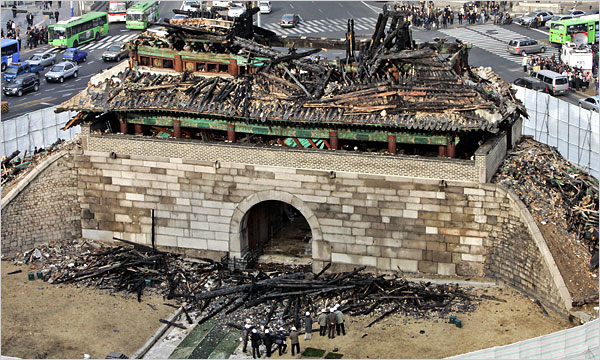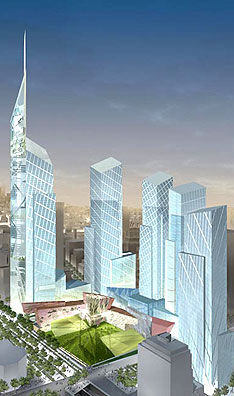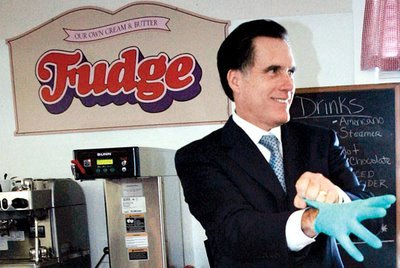As part of writing the Introduction to the forthcoming Handbook of Internet Politics, Phil Howard and I wanted to try a basic 'first take' on what web 2.0 might mean for politics. We sought to briefly define it and to tease out its broader implications for political behaviour in a way that stays close to its technological characteristics without reducing it to those characteristics. We took as our point of departure Tim O'Reilly's influential approach. No surprises there, but we were intrigued by how readily O'Reilly's technology-centric themes could feed into broader conceptual ideas and examples of value to social scientists. Here's what we came up with. We hope you find it useful, and, dare we say it, that you might like to add your comments at the bottom of this post...
[Note: This is a pre-publication excerpt from Andrew Chadwick and Philip N. Howard 'Introduction: New Directions in Internet Politics Research' in Andrew Chadwick and Philip N. Howard (eds) (2008, in press) The Handbook of Internet Politics. New York and London: Routledge. You can read the book's table of contents at Routledge's site]
Politics: Web 2.0
Space limits preclude a full discussion of web 2.0 here, but in this section we highlight its central features by building upon Tim O'Reilly's (2005) seminal approach. For good or ill, this is arguably the most influential discussion of the term to date.
O'Reilly is regarded as the first to publicly coin the term web 2.0 in 20031. This primarily technology-focused approach defines it in terms of seven key principles or themes. Some of these are more relevant to internet politics than others, and some require extra theoretical work to render them amenable to social science investigation. Nevertheless, the seven principles are: the internet as a platform for political discourse; the collective intelligence emergent from political web use; the importance of data over particular software and hardware applications; perpetual experimentalism in the public domain; the creation of small scale forms of political engagement through consumerism; the propagation of political content over multiple applications; and rich user experiences on political websites. How might these principles work as a means—both literal and metaphorical—of sketching out a first take on new directions in the realm of internet politics research?
First, the internet as a platform for political discourse. In essence, this theme relates to the idea that the web has moved from the older model of static pages toward a means of enabling a wide range of goals to be achieved through networked software services. The archetypal web 2.0 web-as-platform service is of course Google, whose value depends almost entirely on its ability to create wealth from the interface of its distributed advertising network, its search algorithm, and its huge database of crawled pages. Two key features of this aspect of web 2.0 are particularly salient: first, the power of easily scalable networks and second, the "long tail". Easily scalable networking involves an organization being able to flexibly adapt to sudden growth surges and ad hoc events that increase demand for its services.
The theory of the long tail (Anderson, 2006) is that online commerce and distribution is changing the economics of content creation and distribution. Traditionally, movie studios, publishers and record companies tend to try to create small numbers of big hit products because the sunk costs of developing a film, book, or album can be more quickly and predictably recouped. Similarly, real space retail outlets (cinemas, city center record stores, booksellers) can only afford to sell "hit" products because the relatively high cost of providing shelf or screen space for low-selling niche products makes it risky. Online distribution significantly reduces these costs, resulting in a sales/products curve with a large "head" and a long "tail" of niches. The internet thus contributes to a more diverse and pluralistic media landscape.
These web-as-platform principles can be seen at work in a range of political arenas. Elsewhere it has been argued that the 2004 primary and presidential campaign in the United States saw the emergence of a model of campaigning that relied upon a range of online venues loosely meshed together through automated linking technologies, particularly blogs, as well as face to face meetings coordinated via the user-generated Meetup site (Chadwick, 2007; Hindman, 2005). However, nowhere is the idea more strongly embodied than in the recent shift towards online social networking on platforms such as Facebook and MySpace. The symbolic moment came in January 2007, when John Edwards announced his candidacy for the Democratic presidential nomination via a brief and informal video posting on Youtube, but the US midterms of November 2006 had already witnessed an explosion of political activity on social networking sites as well as the intensification of blogging by candidates and the long tail of amateur pundits.
The second theme of web 2.0 is collective intelligence. The core idea here is that a distributed network of creators and contributors, the majority of them amateurs, can, using simple tools, produce information goods that may outperform those produced by so-called authoritative, concentrated sources. Examples of this abound, but two stand out as having caught the political imagination: free and open source software projects and user-generated content sites. The underlying model of online collaboration that produces these vast collections of human intelligence has been much debated. Opinions differ, for instance, over the extent to which hierarchy matters in these environments. Some, such as Weber (2004) suggest that it accounts for a great deal, while others, such as Weinberger (2007), downplay its importance. These debates aside, this theme points to the growth of a deeply voluntarist model of content creation and knowledge aggregation.
At a basic level, many of the most interesting and significant developments in online collective action have been enabled by free and open source software creations. This provides a perfect example of the elective affinity between political values and technological tools. Wikipedia itself has become a political battleground, as supporters of candidates, causes, groups, movements, even regimes, engage in incessant "edit wars" over entries. Beyond this, the principle animates politics in a variety of arenas. The blogosphere has enabled ongoing citizen vigilance on a grand scale. Political actors and media elites now exist in an always-on environment in which it is impossible to escape the "little brother" surveillant gaze of citizen-reporters. From Flickr photostreams of marches and demonstrations ignored by the mainstream media to bloggers such as Connecticut Bob, who took to the streets with his home movie camera to film Senator Joseph Lieberman's off-the-cuff remarks in the 2006 US midterms, the media environment for politics has shifted.
The third principle of web 2.0 concerns the importance of data. The central claim here is that the web 2.0 era is characterized by the aggregation of huge amounts of information, and those who can successfully mine, refine and subsequently protect it are likely to emerge as dominant. Most of these data have been created from the concentrated labor of volunteers (Andrejevic, 2002) or they may simply be the by-products of countless, coincidental interactions. But the key point is that informational value emerges from the confluence of distributed user-generated content and its centralized exploitation.
When used as an analytical lens for internet politics, this principle points to the ongoing importance of long-standing controversies surrounding privacy, surveillance and the commercial and political use of personal information (Howard, 2006). The irony is that the celebrated freedom of political expression via self-publishing and the ease of connection facilitated in the social networking environments of web 2.0 also offer a multitude of possibilities for automated gathering, sorting and targeting. In the early days of the web political actors would often be heard complaining that they had "no control" over the online environment or that they did not know how to target particular groups or supporters (Stromer-Galley, 2000). The applications of web 2.0 arguably render these tasks much more manageable, as individuals willingly produce and reveal the most elaborate information about their tastes and preferences within enclosed, proprietary technological frameworks. In the realm of political campaigns, social networking sites thus offer many advantages over the open web. For governments seeking to filter or control internet content, the advantages are also plain.
The fourth theme is perpetual experimentalism in the public domain. As indicated above, the attraction of O'Reilly's model is that it captures literal, quite narrow developments in technological practice but it can also be used at a metaphorical level to capture social and political behavior. Web 2.0 applications have been characterized by an unusual amount of public experimentalism. This is most obviously illustrated by the "perpetually beta" status of many of the popular services. While this is a reflection of the requirements of building and testing scalable web applications on meager resources, it also reflects something of a value shift away from tightly managed development environments towards those characterized by fluidity and greater collaboration between developers and users.
This sense of democratic experimentalism has of course been one of the driving values of the internet since its earliest days (Chadwick, 2006: 38-48). But web 2.0 has seen it proliferate across a surprising range of political activities. Election campaigns in the United States are now characterized by obsessive and continuous recalibration in response to instant online polls, fundraising drives, comments lists on Youtube video pages, and blog and forum posts. But perhaps a better example of the impact of the permanent beta in politics is the British prime minister's e-petitions initiative, "launched" in November 2006. At the time of writing, the site remains in beta, and will probably do so for some time to come, or until it metamorphoses into another application. Adding the beta stamp to an e-government initiative at the heart of the executive machinery of one of the world's oldest liberal democracies tells us just how far the penetration of internet values and working practices has gone.
The next two web 2.0 themes – the creation of small scale forms of political engagement through consumerism and the propagation of political content across multiple applications - are more specialized but still reveal important aspects of the new politics. Many data cannot be sealed off from public use because it would be politically unacceptable, or a business model might depend upon open access. A celebrated aspect of web 2.0 is the mashing together of different data in pursuit of goals that differ from those originally intended. In political life, this practice often grants increased power to citizens. For example, British activist volunteer group MySociety have launched a number of sites, such as Theyworkforyou.org and Fixmystreet.org, that combine publicly accessible government data with user-generated input. Theyrule.net allows users to expose the social ties among political and economic elites by mapping out the network structures of the corporate boards of multinational firms. Meanwhile, mobile internet devices are increasingly important, again with a distinct user-generated inflection through practices such as video and photoblogging, as well as mainstream news organizations' increasing reliance on amateur "witness reporters" as Stanyer argues in this volume.
The final theme is rich user experiences on political websites. In the narrow technical sense this refers to the development of applications designed to run code inside a web browser in ways that facilitate interactivity and the rapid retrieval, alteration and storage of data. Most of the successful web 2.0 applications combine such capabilities with back end databases that store user generated content that can be modified by others. While valuable information is created by such actions, these are often not the result of heroic individual efforts but of aggregated small-scale, low-threshold forms of behavior: seemingly "happy accident" outcomes of thousands of individual interactions (Chadwick, 2007: 290). But these are not entirely accidental: many web 2.0 systems are deliberately designed to capture aggregated data from even the most minimal of user activities. This occurs on sites that encourage users to create original content but which also offer readers the chance to rate it. To take just a couple of examples, highly-rated pieces rise to the top of the recommended diaries feature on the Daily Kos home page, while MoveOn.org's Action Forum contains a similar mechanism for prioritizing issues.
Perhaps the most significant aspect of web 2.0 politics as rich user experience has emerged in the form of online video. The explosion of user-generated video content in 2005 took most commentators by surprise. Past predictions of media convergence generally argued that an abundance of bandwidth would make the internet a more televisual, large screen experience. There are developments in this area, with IPTV applications such as Joost and the BBC's iPlayer launching in 2007 on the basis of deals to stream large screen quality video across adapted peer-to-peer networks. However, the main event in online video to date is the user-generated site Youtube, initially an independent company established by two individuals, but acquired by Google in early 2007 for $1.65 billion. Youtube may eventually metamorphose into a fully converged large screen online "broadcasting" network, but the indications so far are that it will not. This is primarily because it has generated a huge regular user base that savors its small screen, DIY format.
In the political sphere, Youtube has made a sizeable dent in earlier predictions of the emergence of slick, professionalized televisual online campaigns able only to be resourced by wealthy candidates and their campaign teams (Margolis and Resnick, 2000). This is clearly wide of the mark when both political elites and citizens perceive that the visual genres of an effective Youtube video do not depend upon professional media production techniques. The cynical may decry the rise of Youtube political campaigning on the grounds that it is inauthentic "spin" based on manufactured folksy imagery. In the United Kingdom, the Conservative Party leader David Cameron was widely criticized by the mainstream media for this approach on his site Webcameron, launched in 2006. And yet the impressionistic evidence suggests that the method attracts members of the public, evidenced by 28,000 postings within five months of that forum's launch in May 2007 (Webcameron.org, 2007). And in important ways, each new digital technology that captures public attention quickly becomes politicized. YouTube has become one of the most popular online applications, essentially a tool for content distribution by political campaigns.
Technologies may possess inherent properties that shape and constrain political norms, rules and behavior, but these must be situated within political contexts (Chadwick, 2006: 17-21). The seven themes of web 2.0 discussed above are by no means exhaustive and only begin to provide analytical purchase on the huge changes currently underway in internet politics. Yet it would be a mistake to dismiss web 2.0 as the creation of marketing and public relations. All of the chapters in this collection provide tools for making sense of the sometimes remarkable pace of these recent changes, yet they do so while also recognizing the continuities with the internet's earlier phases.
Note
1. O'Reilly's original principles are: "the web as platform"; "harnessing collective intelligence"; "data is the next "Intel inside""; "the end of the software release cycle"; "lightweight programming models"; "software above the level of a single device"; and "rich user experiences". See O'Reilly, 2005.
References
Anderson, K. (2006). The long tail: Why the future of business is selling less of more. New York: Hyperion.
Andrejevic, M. (2002). The work of being watched: Interactive media and the exploitation of self-disclosure. Critical Studies in Media Communication, 19(2), 230-248.
Chadwick, A. (2006). Internet politics: States, citizens, and new communication technologies. New York: Oxford University Press.
Chadwick, A. (2007). Digital network repertoires and organizational hybridity. Political Communication, 24(3), 283-301.
Hindman, M. (2005). The real lessons of Howard Dean: Reflections on the first digital campaign. Perspectives on Politics, 3(1), 121-128.
Howard, P. N. (2006). New media campaigns and the managed citizen. Cambridge: Cambridge University Press.
Margolis, M., & Resnick, D. (2000). Politics as usual: The cyberspace revolution. Thousand Oaks, CA: Sage.
O'Reilly, T. (2005). What is web 2.0?: Design patterns and business models for the next generation of software. Retrieved November 12, 2007, from http://www.oreilly.com/lpt/a/6228
Stromer-Galley, J. (2000). Online interaction and why candidates avoid it. Journal of Communication, 50(4), 111-132.
Weber, S. (2004). The success of open source. Cambridge, MA: Harvard University Press.
Weinberger, D. (2007). Everything is miscellaneous: The power of the new digital disorder. New York: Henry Holt and Company.




